Analyzing Huawei's Market Entry: Opportunities & Challenges in India
VerifiedAdded on 2023/04/26
|17
|5619
|441
Case Study
AI Summary
This case study delves into Huawei's strategic entry into the Indian market, highlighting both the opportunities and challenges the company faced. It examines how Huawei, a leading Chinese telecommunications organization, navigated the complexities of the Indian market, including building brand recognition, overcoming political and cultural barriers, and addressing perceptions of low-quality merchandise. The study further explores the benefits and drivers of globalization, with a focus on technological innovation and international trade. It also touches upon the Copenhagen criteria for EU membership, providing a comprehensive overview of the factors influencing Huawei's success and the broader dynamics of international business. Desklib offers this case study as a resource for students seeking to understand global market entry strategies and the challenges of international expansion.
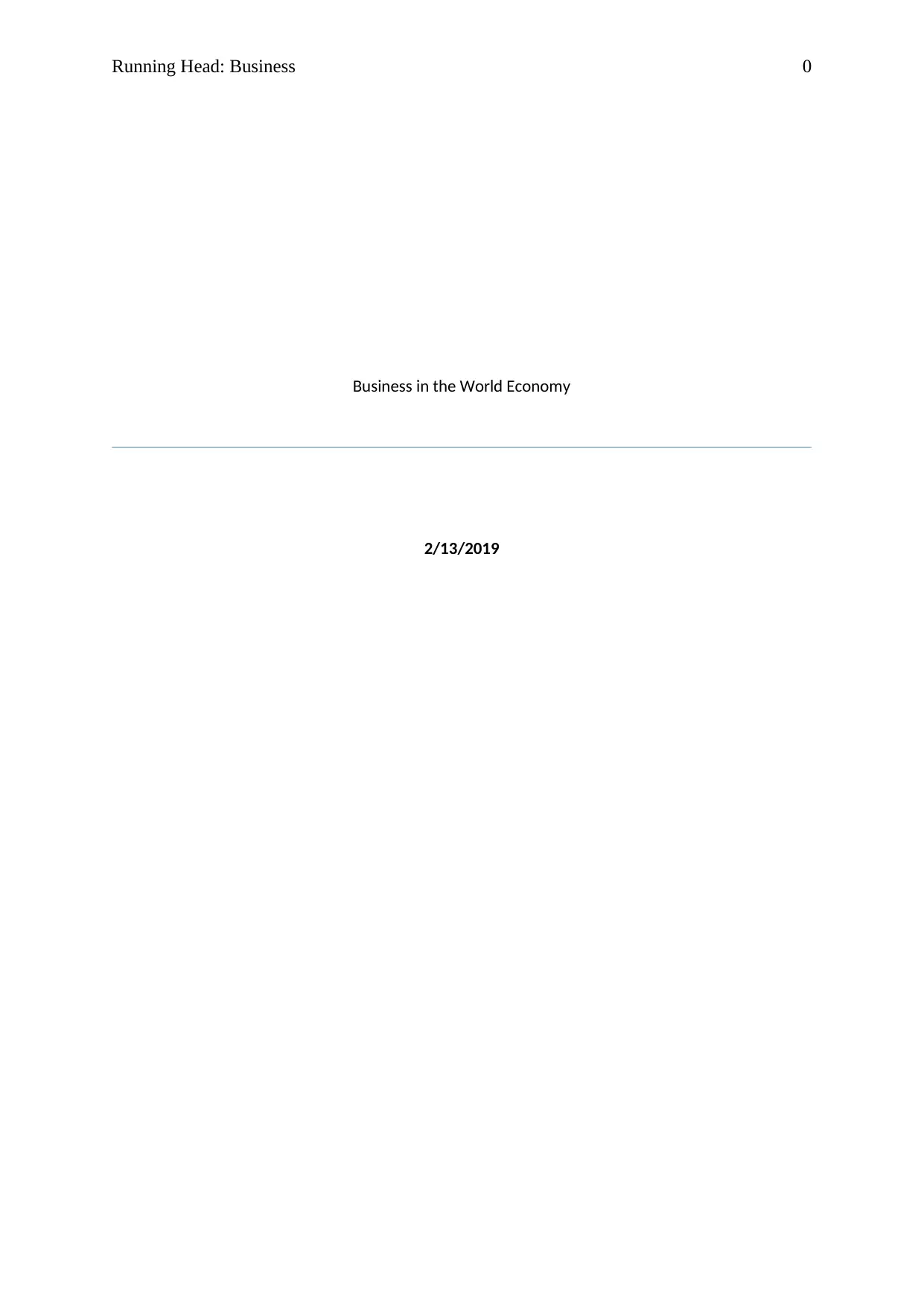
Running Head: Business 0
Business in the World Economy
2/13/2019
Business in the World Economy
2/13/2019
Paraphrase This Document
Need a fresh take? Get an instant paraphrase of this document with our AI Paraphraser
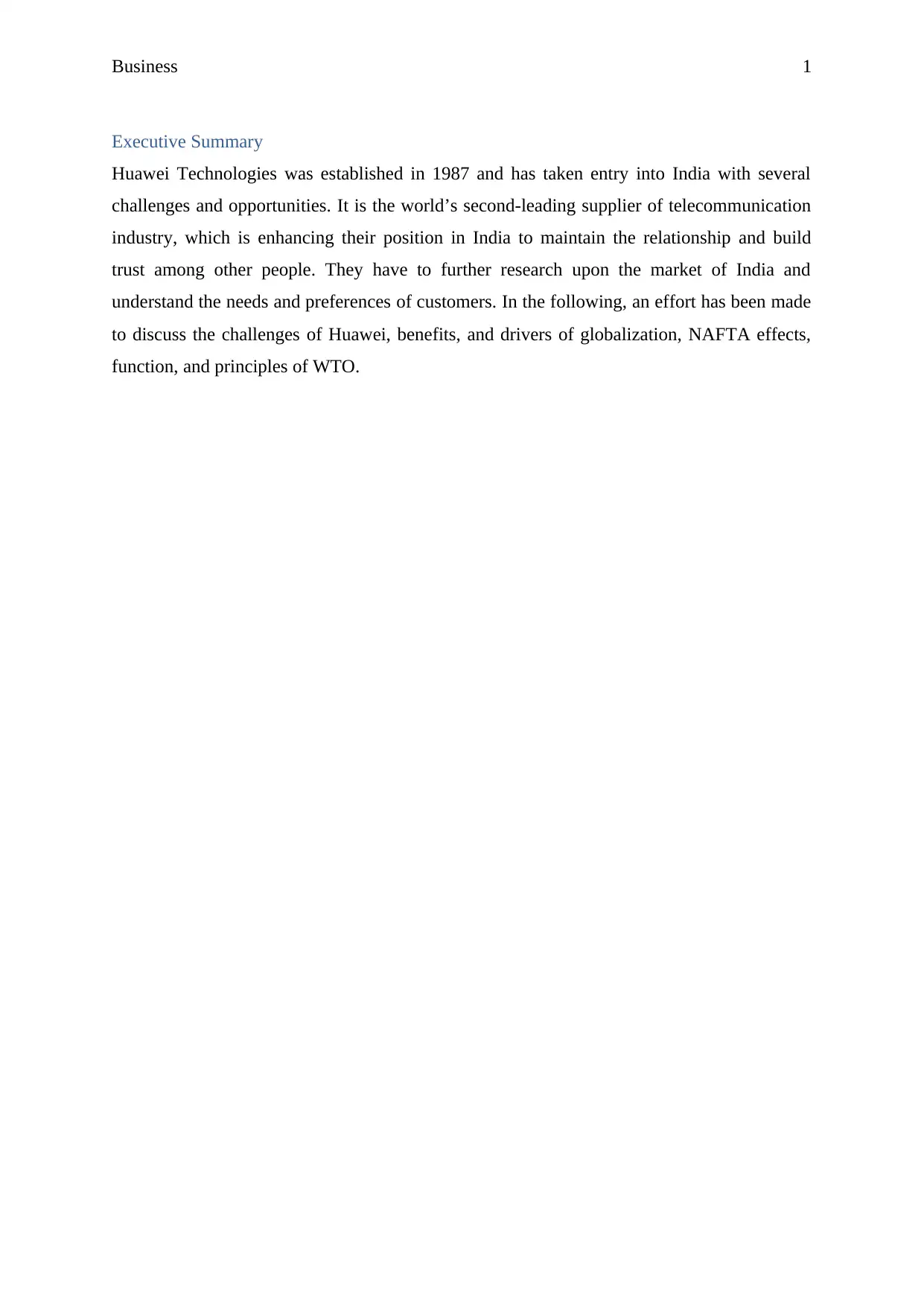
Business 1
Executive Summary
Huawei Technologies was established in 1987 and has taken entry into India with several
challenges and opportunities. It is the world’s second-leading supplier of telecommunication
industry, which is enhancing their position in India to maintain the relationship and build
trust among other people. They have to further research upon the market of India and
understand the needs and preferences of customers. In the following, an effort has been made
to discuss the challenges of Huawei, benefits, and drivers of globalization, NAFTA effects,
function, and principles of WTO.
Executive Summary
Huawei Technologies was established in 1987 and has taken entry into India with several
challenges and opportunities. It is the world’s second-leading supplier of telecommunication
industry, which is enhancing their position in India to maintain the relationship and build
trust among other people. They have to further research upon the market of India and
understand the needs and preferences of customers. In the following, an effort has been made
to discuss the challenges of Huawei, benefits, and drivers of globalization, NAFTA effects,
function, and principles of WTO.

Business 2
Contents
Executive Summary...............................................................................................................................1
Introduction...........................................................................................................................................3
Case Study: Huawei..............................................................................................................................3
Conclusion...........................................................................................................................................13
References...........................................................................................................................................14
Contents
Executive Summary...............................................................................................................................1
Introduction...........................................................................................................................................3
Case Study: Huawei..............................................................................................................................3
Conclusion...........................................................................................................................................13
References...........................................................................................................................................14
⊘ This is a preview!⊘
Do you want full access?
Subscribe today to unlock all pages.

Trusted by 1+ million students worldwide
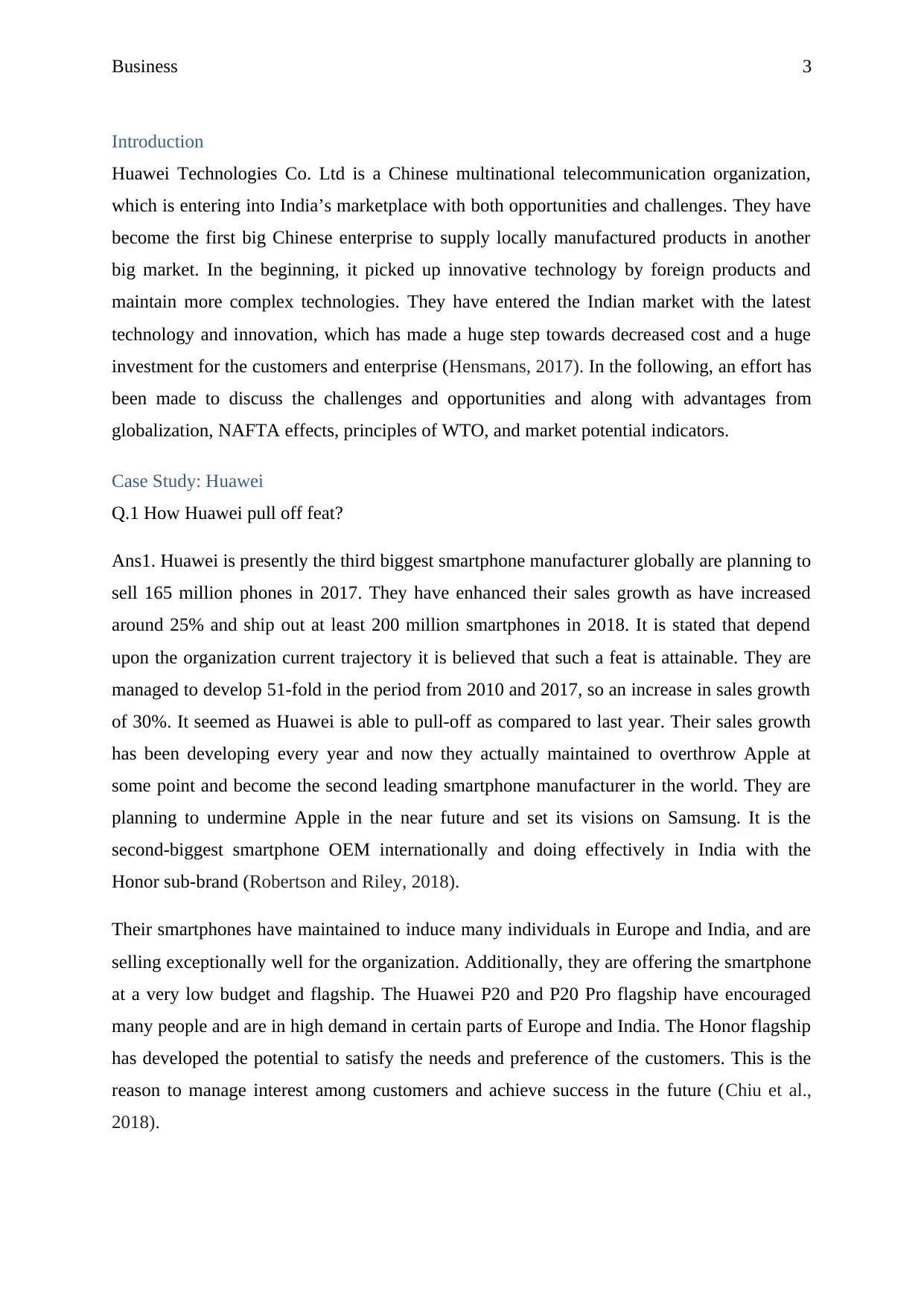
Business 3
Introduction
Huawei Technologies Co. Ltd is a Chinese multinational telecommunication organization,
which is entering into India’s marketplace with both opportunities and challenges. They have
become the first big Chinese enterprise to supply locally manufactured products in another
big market. In the beginning, it picked up innovative technology by foreign products and
maintain more complex technologies. They have entered the Indian market with the latest
technology and innovation, which has made a huge step towards decreased cost and a huge
investment for the customers and enterprise (Hensmans, 2017). In the following, an effort has
been made to discuss the challenges and opportunities and along with advantages from
globalization, NAFTA effects, principles of WTO, and market potential indicators.
Case Study: Huawei
Q.1 How Huawei pull off feat?
Ans1. Huawei is presently the third biggest smartphone manufacturer globally are planning to
sell 165 million phones in 2017. They have enhanced their sales growth as have increased
around 25% and ship out at least 200 million smartphones in 2018. It is stated that depend
upon the organization current trajectory it is believed that such a feat is attainable. They are
managed to develop 51-fold in the period from 2010 and 2017, so an increase in sales growth
of 30%. It seemed as Huawei is able to pull-off as compared to last year. Their sales growth
has been developing every year and now they actually maintained to overthrow Apple at
some point and become the second leading smartphone manufacturer in the world. They are
planning to undermine Apple in the near future and set its visions on Samsung. It is the
second-biggest smartphone OEM internationally and doing effectively in India with the
Honor sub-brand (Robertson and Riley, 2018).
Their smartphones have maintained to induce many individuals in Europe and India, and are
selling exceptionally well for the organization. Additionally, they are offering the smartphone
at a very low budget and flagship. The Huawei P20 and P20 Pro flagship have encouraged
many people and are in high demand in certain parts of Europe and India. The Honor flagship
has developed the potential to satisfy the needs and preference of the customers. This is the
reason to manage interest among customers and achieve success in the future (Chiu et al.,
2018).
Introduction
Huawei Technologies Co. Ltd is a Chinese multinational telecommunication organization,
which is entering into India’s marketplace with both opportunities and challenges. They have
become the first big Chinese enterprise to supply locally manufactured products in another
big market. In the beginning, it picked up innovative technology by foreign products and
maintain more complex technologies. They have entered the Indian market with the latest
technology and innovation, which has made a huge step towards decreased cost and a huge
investment for the customers and enterprise (Hensmans, 2017). In the following, an effort has
been made to discuss the challenges and opportunities and along with advantages from
globalization, NAFTA effects, principles of WTO, and market potential indicators.
Case Study: Huawei
Q.1 How Huawei pull off feat?
Ans1. Huawei is presently the third biggest smartphone manufacturer globally are planning to
sell 165 million phones in 2017. They have enhanced their sales growth as have increased
around 25% and ship out at least 200 million smartphones in 2018. It is stated that depend
upon the organization current trajectory it is believed that such a feat is attainable. They are
managed to develop 51-fold in the period from 2010 and 2017, so an increase in sales growth
of 30%. It seemed as Huawei is able to pull-off as compared to last year. Their sales growth
has been developing every year and now they actually maintained to overthrow Apple at
some point and become the second leading smartphone manufacturer in the world. They are
planning to undermine Apple in the near future and set its visions on Samsung. It is the
second-biggest smartphone OEM internationally and doing effectively in India with the
Honor sub-brand (Robertson and Riley, 2018).
Their smartphones have maintained to induce many individuals in Europe and India, and are
selling exceptionally well for the organization. Additionally, they are offering the smartphone
at a very low budget and flagship. The Huawei P20 and P20 Pro flagship have encouraged
many people and are in high demand in certain parts of Europe and India. The Honor flagship
has developed the potential to satisfy the needs and preference of the customers. This is the
reason to manage interest among customers and achieve success in the future (Chiu et al.,
2018).
Paraphrase This Document
Need a fresh take? Get an instant paraphrase of this document with our AI Paraphraser
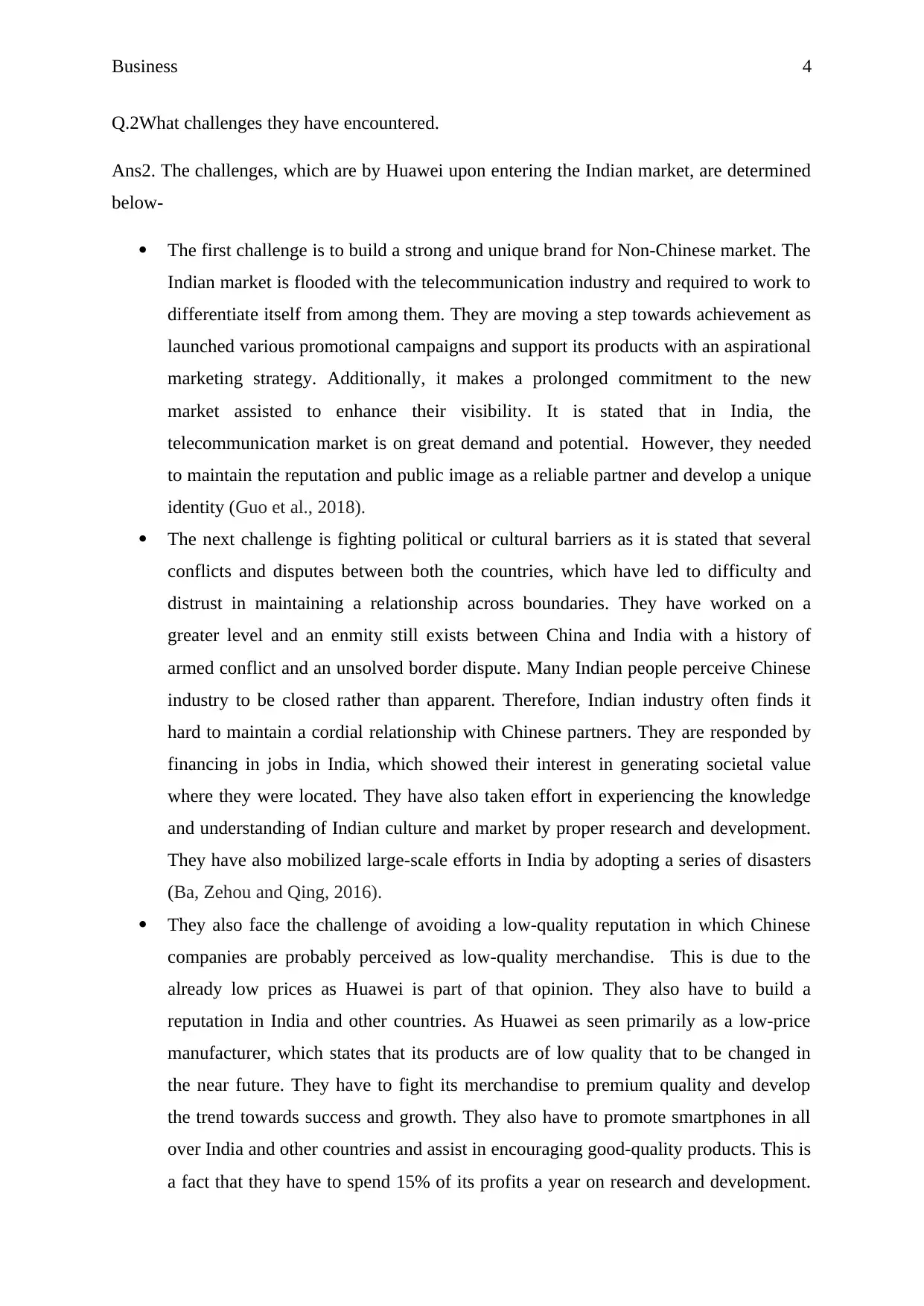
Business 4
Q.2What challenges they have encountered.
Ans2. The challenges, which are by Huawei upon entering the Indian market, are determined
below-
The first challenge is to build a strong and unique brand for Non-Chinese market. The
Indian market is flooded with the telecommunication industry and required to work to
differentiate itself from among them. They are moving a step towards achievement as
launched various promotional campaigns and support its products with an aspirational
marketing strategy. Additionally, it makes a prolonged commitment to the new
market assisted to enhance their visibility. It is stated that in India, the
telecommunication market is on great demand and potential. However, they needed
to maintain the reputation and public image as a reliable partner and develop a unique
identity (Guo et al., 2018).
The next challenge is fighting political or cultural barriers as it is stated that several
conflicts and disputes between both the countries, which have led to difficulty and
distrust in maintaining a relationship across boundaries. They have worked on a
greater level and an enmity still exists between China and India with a history of
armed conflict and an unsolved border dispute. Many Indian people perceive Chinese
industry to be closed rather than apparent. Therefore, Indian industry often finds it
hard to maintain a cordial relationship with Chinese partners. They are responded by
financing in jobs in India, which showed their interest in generating societal value
where they were located. They have also taken effort in experiencing the knowledge
and understanding of Indian culture and market by proper research and development.
They have also mobilized large-scale efforts in India by adopting a series of disasters
(Ba, Zehou and Qing, 2016).
They also face the challenge of avoiding a low-quality reputation in which Chinese
companies are probably perceived as low-quality merchandise. This is due to the
already low prices as Huawei is part of that opinion. They also have to build a
reputation in India and other countries. As Huawei as seen primarily as a low-price
manufacturer, which states that its products are of low quality that to be changed in
the near future. They have to fight its merchandise to premium quality and develop
the trend towards success and growth. They also have to promote smartphones in all
over India and other countries and assist in encouraging good-quality products. This is
a fact that they have to spend 15% of its profits a year on research and development.
Q.2What challenges they have encountered.
Ans2. The challenges, which are by Huawei upon entering the Indian market, are determined
below-
The first challenge is to build a strong and unique brand for Non-Chinese market. The
Indian market is flooded with the telecommunication industry and required to work to
differentiate itself from among them. They are moving a step towards achievement as
launched various promotional campaigns and support its products with an aspirational
marketing strategy. Additionally, it makes a prolonged commitment to the new
market assisted to enhance their visibility. It is stated that in India, the
telecommunication market is on great demand and potential. However, they needed
to maintain the reputation and public image as a reliable partner and develop a unique
identity (Guo et al., 2018).
The next challenge is fighting political or cultural barriers as it is stated that several
conflicts and disputes between both the countries, which have led to difficulty and
distrust in maintaining a relationship across boundaries. They have worked on a
greater level and an enmity still exists between China and India with a history of
armed conflict and an unsolved border dispute. Many Indian people perceive Chinese
industry to be closed rather than apparent. Therefore, Indian industry often finds it
hard to maintain a cordial relationship with Chinese partners. They are responded by
financing in jobs in India, which showed their interest in generating societal value
where they were located. They have also taken effort in experiencing the knowledge
and understanding of Indian culture and market by proper research and development.
They have also mobilized large-scale efforts in India by adopting a series of disasters
(Ba, Zehou and Qing, 2016).
They also face the challenge of avoiding a low-quality reputation in which Chinese
companies are probably perceived as low-quality merchandise. This is due to the
already low prices as Huawei is part of that opinion. They also have to build a
reputation in India and other countries. As Huawei as seen primarily as a low-price
manufacturer, which states that its products are of low quality that to be changed in
the near future. They have to fight its merchandise to premium quality and develop
the trend towards success and growth. They also have to promote smartphones in all
over India and other countries and assist in encouraging good-quality products. This is
a fact that they have to spend 15% of its profits a year on research and development.
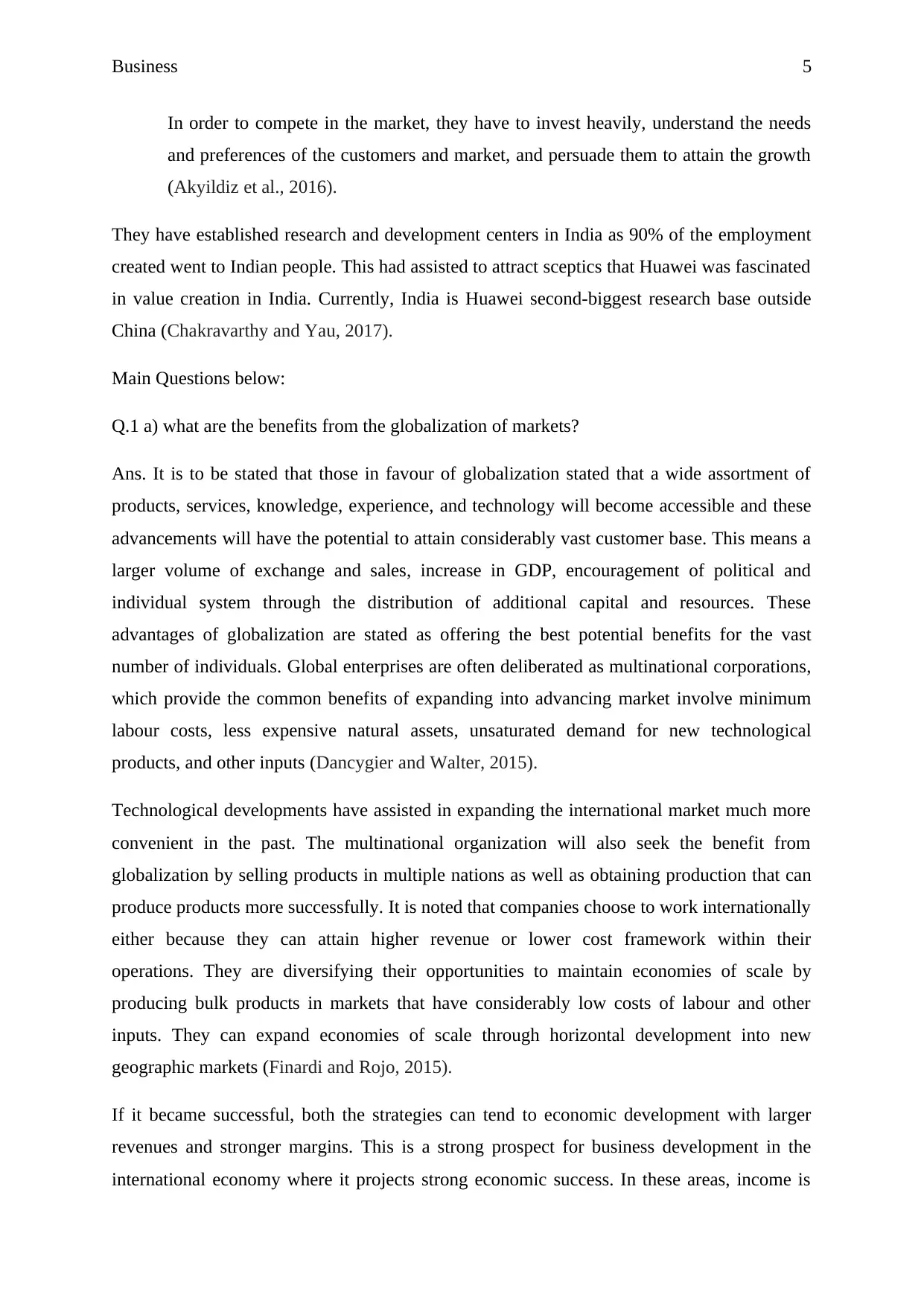
Business 5
In order to compete in the market, they have to invest heavily, understand the needs
and preferences of the customers and market, and persuade them to attain the growth
(Akyildiz et al., 2016).
They have established research and development centers in India as 90% of the employment
created went to Indian people. This had assisted to attract sceptics that Huawei was fascinated
in value creation in India. Currently, India is Huawei second-biggest research base outside
China (Chakravarthy and Yau, 2017).
Main Questions below:
Q.1 a) what are the benefits from the globalization of markets?
Ans. It is to be stated that those in favour of globalization stated that a wide assortment of
products, services, knowledge, experience, and technology will become accessible and these
advancements will have the potential to attain considerably vast customer base. This means a
larger volume of exchange and sales, increase in GDP, encouragement of political and
individual system through the distribution of additional capital and resources. These
advantages of globalization are stated as offering the best potential benefits for the vast
number of individuals. Global enterprises are often deliberated as multinational corporations,
which provide the common benefits of expanding into advancing market involve minimum
labour costs, less expensive natural assets, unsaturated demand for new technological
products, and other inputs (Dancygier and Walter, 2015).
Technological developments have assisted in expanding the international market much more
convenient in the past. The multinational organization will also seek the benefit from
globalization by selling products in multiple nations as well as obtaining production that can
produce products more successfully. It is noted that companies choose to work internationally
either because they can attain higher revenue or lower cost framework within their
operations. They are diversifying their opportunities to maintain economies of scale by
producing bulk products in markets that have considerably low costs of labour and other
inputs. They can expand economies of scale through horizontal development into new
geographic markets (Finardi and Rojo, 2015).
If it became successful, both the strategies can tend to economic development with larger
revenues and stronger margins. This is a strong prospect for business development in the
international economy where it projects strong economic success. In these areas, income is
In order to compete in the market, they have to invest heavily, understand the needs
and preferences of the customers and market, and persuade them to attain the growth
(Akyildiz et al., 2016).
They have established research and development centers in India as 90% of the employment
created went to Indian people. This had assisted to attract sceptics that Huawei was fascinated
in value creation in India. Currently, India is Huawei second-biggest research base outside
China (Chakravarthy and Yau, 2017).
Main Questions below:
Q.1 a) what are the benefits from the globalization of markets?
Ans. It is to be stated that those in favour of globalization stated that a wide assortment of
products, services, knowledge, experience, and technology will become accessible and these
advancements will have the potential to attain considerably vast customer base. This means a
larger volume of exchange and sales, increase in GDP, encouragement of political and
individual system through the distribution of additional capital and resources. These
advantages of globalization are stated as offering the best potential benefits for the vast
number of individuals. Global enterprises are often deliberated as multinational corporations,
which provide the common benefits of expanding into advancing market involve minimum
labour costs, less expensive natural assets, unsaturated demand for new technological
products, and other inputs (Dancygier and Walter, 2015).
Technological developments have assisted in expanding the international market much more
convenient in the past. The multinational organization will also seek the benefit from
globalization by selling products in multiple nations as well as obtaining production that can
produce products more successfully. It is noted that companies choose to work internationally
either because they can attain higher revenue or lower cost framework within their
operations. They are diversifying their opportunities to maintain economies of scale by
producing bulk products in markets that have considerably low costs of labour and other
inputs. They can expand economies of scale through horizontal development into new
geographic markets (Finardi and Rojo, 2015).
If it became successful, both the strategies can tend to economic development with larger
revenues and stronger margins. This is a strong prospect for business development in the
international economy where it projects strong economic success. In these areas, income is
⊘ This is a preview!⊘
Do you want full access?
Subscribe today to unlock all pages.

Trusted by 1+ million students worldwide
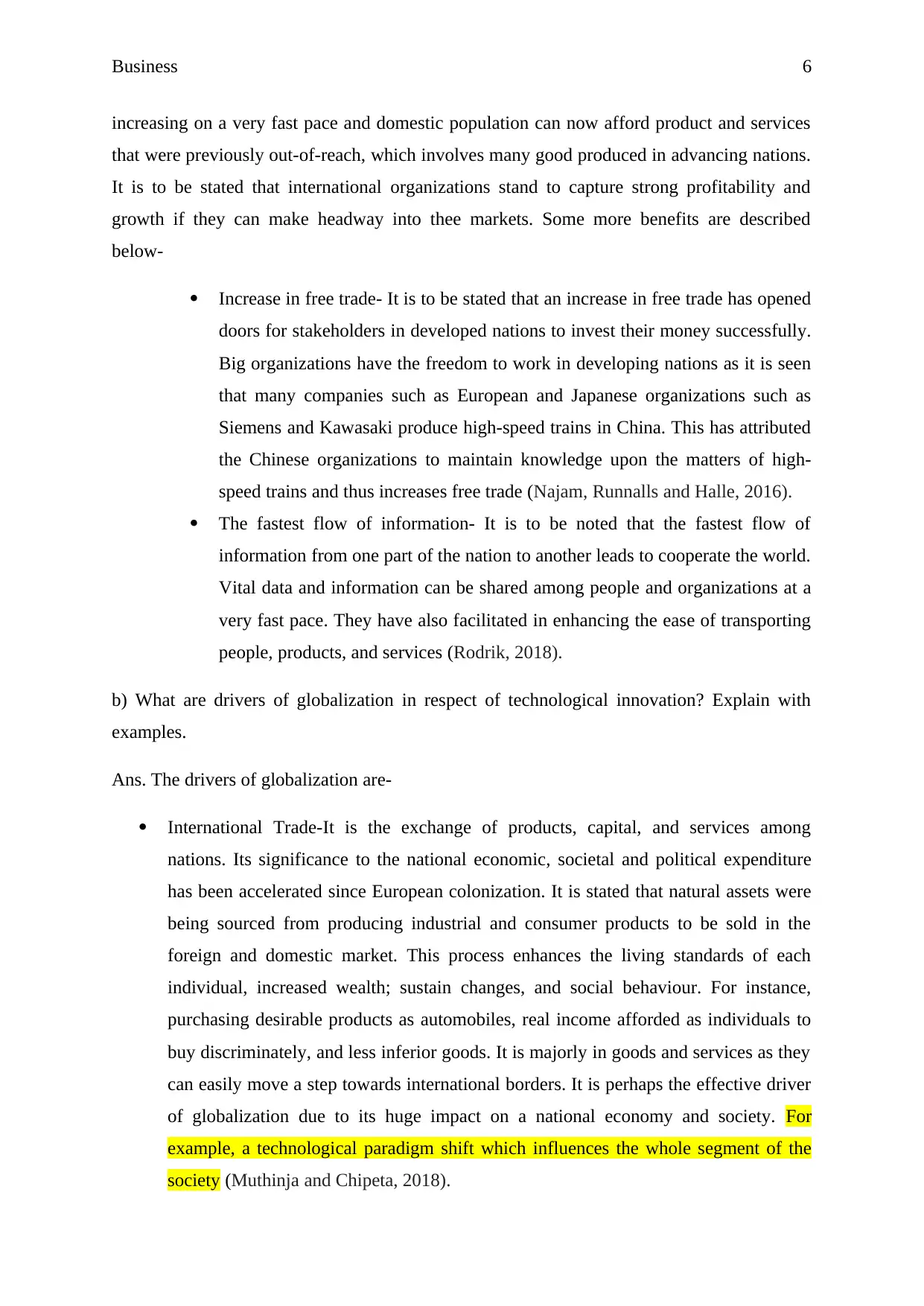
Business 6
increasing on a very fast pace and domestic population can now afford product and services
that were previously out-of-reach, which involves many good produced in advancing nations.
It is to be stated that international organizations stand to capture strong profitability and
growth if they can make headway into thee markets. Some more benefits are described
below-
Increase in free trade- It is to be stated that an increase in free trade has opened
doors for stakeholders in developed nations to invest their money successfully.
Big organizations have the freedom to work in developing nations as it is seen
that many companies such as European and Japanese organizations such as
Siemens and Kawasaki produce high-speed trains in China. This has attributed
the Chinese organizations to maintain knowledge upon the matters of high-
speed trains and thus increases free trade (Najam, Runnalls and Halle, 2016).
The fastest flow of information- It is to be noted that the fastest flow of
information from one part of the nation to another leads to cooperate the world.
Vital data and information can be shared among people and organizations at a
very fast pace. They have also facilitated in enhancing the ease of transporting
people, products, and services (Rodrik, 2018).
b) What are drivers of globalization in respect of technological innovation? Explain with
examples.
Ans. The drivers of globalization are-
International Trade-It is the exchange of products, capital, and services among
nations. Its significance to the national economic, societal and political expenditure
has been accelerated since European colonization. It is stated that natural assets were
being sourced from producing industrial and consumer products to be sold in the
foreign and domestic market. This process enhances the living standards of each
individual, increased wealth; sustain changes, and social behaviour. For instance,
purchasing desirable products as automobiles, real income afforded as individuals to
buy discriminately, and less inferior goods. It is majorly in goods and services as they
can easily move a step towards international borders. It is perhaps the effective driver
of globalization due to its huge impact on a national economy and society. For
example, a technological paradigm shift which influences the whole segment of the
society (Muthinja and Chipeta, 2018).
increasing on a very fast pace and domestic population can now afford product and services
that were previously out-of-reach, which involves many good produced in advancing nations.
It is to be stated that international organizations stand to capture strong profitability and
growth if they can make headway into thee markets. Some more benefits are described
below-
Increase in free trade- It is to be stated that an increase in free trade has opened
doors for stakeholders in developed nations to invest their money successfully.
Big organizations have the freedom to work in developing nations as it is seen
that many companies such as European and Japanese organizations such as
Siemens and Kawasaki produce high-speed trains in China. This has attributed
the Chinese organizations to maintain knowledge upon the matters of high-
speed trains and thus increases free trade (Najam, Runnalls and Halle, 2016).
The fastest flow of information- It is to be noted that the fastest flow of
information from one part of the nation to another leads to cooperate the world.
Vital data and information can be shared among people and organizations at a
very fast pace. They have also facilitated in enhancing the ease of transporting
people, products, and services (Rodrik, 2018).
b) What are drivers of globalization in respect of technological innovation? Explain with
examples.
Ans. The drivers of globalization are-
International Trade-It is the exchange of products, capital, and services among
nations. Its significance to the national economic, societal and political expenditure
has been accelerated since European colonization. It is stated that natural assets were
being sourced from producing industrial and consumer products to be sold in the
foreign and domestic market. This process enhances the living standards of each
individual, increased wealth; sustain changes, and social behaviour. For instance,
purchasing desirable products as automobiles, real income afforded as individuals to
buy discriminately, and less inferior goods. It is majorly in goods and services as they
can easily move a step towards international borders. It is perhaps the effective driver
of globalization due to its huge impact on a national economy and society. For
example, a technological paradigm shift which influences the whole segment of the
society (Muthinja and Chipeta, 2018).
Paraphrase This Document
Need a fresh take? Get an instant paraphrase of this document with our AI Paraphraser
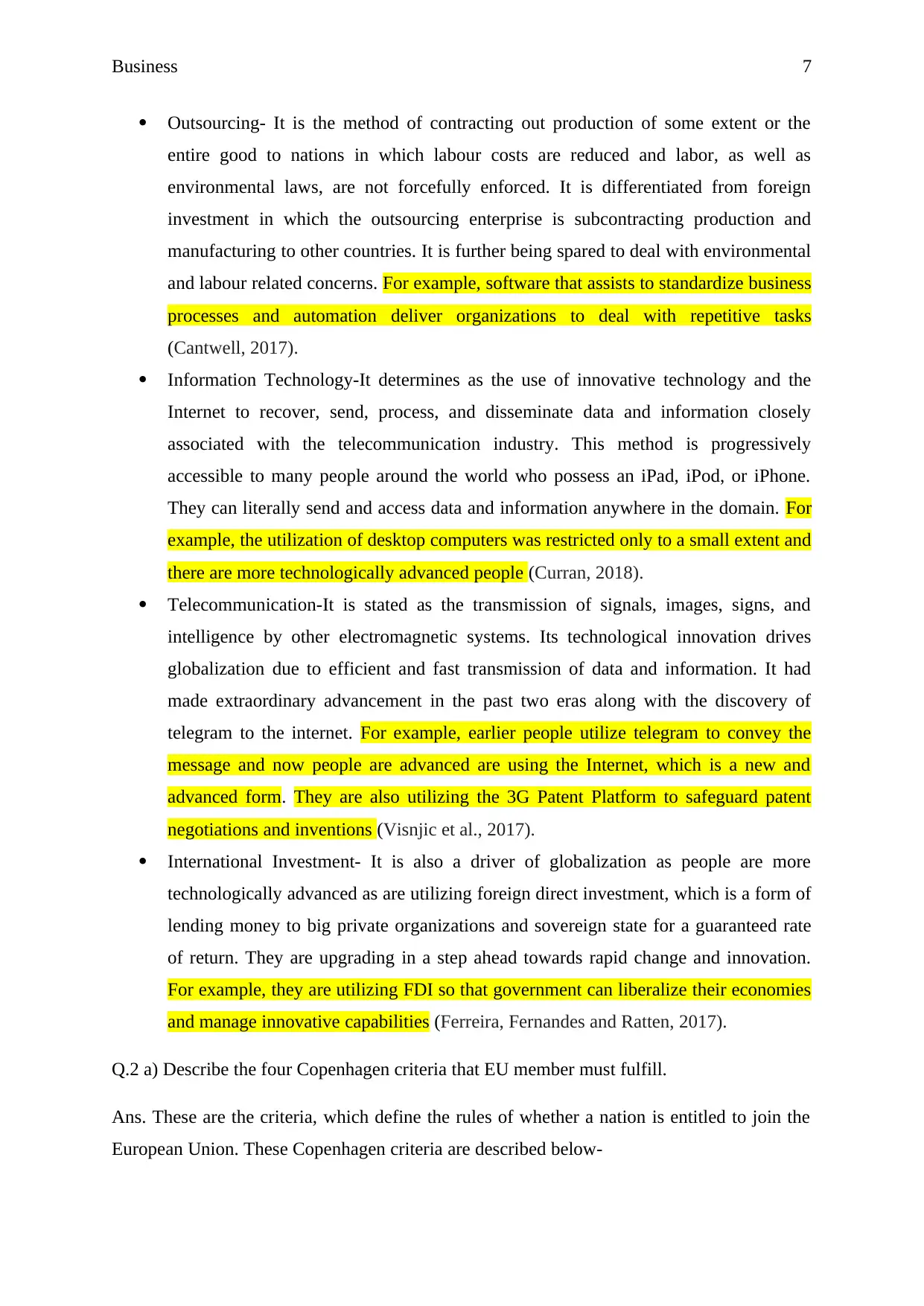
Business 7
Outsourcing- It is the method of contracting out production of some extent or the
entire good to nations in which labour costs are reduced and labor, as well as
environmental laws, are not forcefully enforced. It is differentiated from foreign
investment in which the outsourcing enterprise is subcontracting production and
manufacturing to other countries. It is further being spared to deal with environmental
and labour related concerns. For example, software that assists to standardize business
processes and automation deliver organizations to deal with repetitive tasks
(Cantwell, 2017).
Information Technology-It determines as the use of innovative technology and the
Internet to recover, send, process, and disseminate data and information closely
associated with the telecommunication industry. This method is progressively
accessible to many people around the world who possess an iPad, iPod, or iPhone.
They can literally send and access data and information anywhere in the domain. For
example, the utilization of desktop computers was restricted only to a small extent and
there are more technologically advanced people (Curran, 2018).
Telecommunication-It is stated as the transmission of signals, images, signs, and
intelligence by other electromagnetic systems. Its technological innovation drives
globalization due to efficient and fast transmission of data and information. It had
made extraordinary advancement in the past two eras along with the discovery of
telegram to the internet. For example, earlier people utilize telegram to convey the
message and now people are advanced are using the Internet, which is a new and
advanced form. They are also utilizing the 3G Patent Platform to safeguard patent
negotiations and inventions (Visnjic et al., 2017).
International Investment- It is also a driver of globalization as people are more
technologically advanced as are utilizing foreign direct investment, which is a form of
lending money to big private organizations and sovereign state for a guaranteed rate
of return. They are upgrading in a step ahead towards rapid change and innovation.
For example, they are utilizing FDI so that government can liberalize their economies
and manage innovative capabilities (Ferreira, Fernandes and Ratten, 2017).
Q.2 a) Describe the four Copenhagen criteria that EU member must fulfill.
Ans. These are the criteria, which define the rules of whether a nation is entitled to join the
European Union. These Copenhagen criteria are described below-
Outsourcing- It is the method of contracting out production of some extent or the
entire good to nations in which labour costs are reduced and labor, as well as
environmental laws, are not forcefully enforced. It is differentiated from foreign
investment in which the outsourcing enterprise is subcontracting production and
manufacturing to other countries. It is further being spared to deal with environmental
and labour related concerns. For example, software that assists to standardize business
processes and automation deliver organizations to deal with repetitive tasks
(Cantwell, 2017).
Information Technology-It determines as the use of innovative technology and the
Internet to recover, send, process, and disseminate data and information closely
associated with the telecommunication industry. This method is progressively
accessible to many people around the world who possess an iPad, iPod, or iPhone.
They can literally send and access data and information anywhere in the domain. For
example, the utilization of desktop computers was restricted only to a small extent and
there are more technologically advanced people (Curran, 2018).
Telecommunication-It is stated as the transmission of signals, images, signs, and
intelligence by other electromagnetic systems. Its technological innovation drives
globalization due to efficient and fast transmission of data and information. It had
made extraordinary advancement in the past two eras along with the discovery of
telegram to the internet. For example, earlier people utilize telegram to convey the
message and now people are advanced are using the Internet, which is a new and
advanced form. They are also utilizing the 3G Patent Platform to safeguard patent
negotiations and inventions (Visnjic et al., 2017).
International Investment- It is also a driver of globalization as people are more
technologically advanced as are utilizing foreign direct investment, which is a form of
lending money to big private organizations and sovereign state for a guaranteed rate
of return. They are upgrading in a step ahead towards rapid change and innovation.
For example, they are utilizing FDI so that government can liberalize their economies
and manage innovative capabilities (Ferreira, Fernandes and Ratten, 2017).
Q.2 a) Describe the four Copenhagen criteria that EU member must fulfill.
Ans. These are the criteria, which define the rules of whether a nation is entitled to join the
European Union. These Copenhagen criteria are described below-
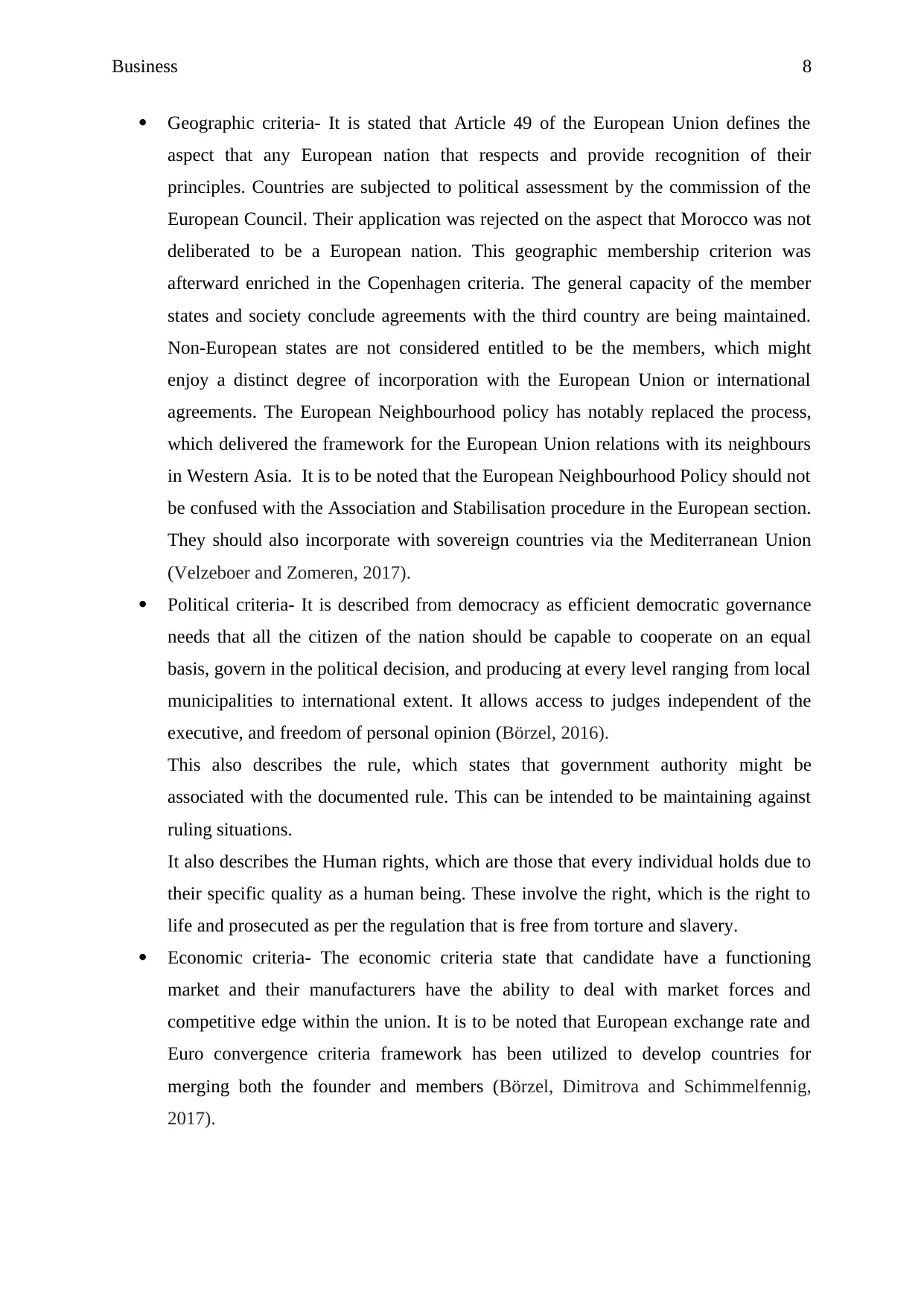
Business 8
Geographic criteria- It is stated that Article 49 of the European Union defines the
aspect that any European nation that respects and provide recognition of their
principles. Countries are subjected to political assessment by the commission of the
European Council. Their application was rejected on the aspect that Morocco was not
deliberated to be a European nation. This geographic membership criterion was
afterward enriched in the Copenhagen criteria. The general capacity of the member
states and society conclude agreements with the third country are being maintained.
Non-European states are not considered entitled to be the members, which might
enjoy a distinct degree of incorporation with the European Union or international
agreements. The European Neighbourhood policy has notably replaced the process,
which delivered the framework for the European Union relations with its neighbours
in Western Asia. It is to be noted that the European Neighbourhood Policy should not
be confused with the Association and Stabilisation procedure in the European section.
They should also incorporate with sovereign countries via the Mediterranean Union
(Velzeboer and Zomeren, 2017).
Political criteria- It is described from democracy as efficient democratic governance
needs that all the citizen of the nation should be capable to cooperate on an equal
basis, govern in the political decision, and producing at every level ranging from local
municipalities to international extent. It allows access to judges independent of the
executive, and freedom of personal opinion (Börzel, 2016).
This also describes the rule, which states that government authority might be
associated with the documented rule. This can be intended to be maintaining against
ruling situations.
It also describes the Human rights, which are those that every individual holds due to
their specific quality as a human being. These involve the right, which is the right to
life and prosecuted as per the regulation that is free from torture and slavery.
Economic criteria- The economic criteria state that candidate have a functioning
market and their manufacturers have the ability to deal with market forces and
competitive edge within the union. It is to be noted that European exchange rate and
Euro convergence criteria framework has been utilized to develop countries for
merging both the founder and members (Börzel, Dimitrova and Schimmelfennig,
2017).
Geographic criteria- It is stated that Article 49 of the European Union defines the
aspect that any European nation that respects and provide recognition of their
principles. Countries are subjected to political assessment by the commission of the
European Council. Their application was rejected on the aspect that Morocco was not
deliberated to be a European nation. This geographic membership criterion was
afterward enriched in the Copenhagen criteria. The general capacity of the member
states and society conclude agreements with the third country are being maintained.
Non-European states are not considered entitled to be the members, which might
enjoy a distinct degree of incorporation with the European Union or international
agreements. The European Neighbourhood policy has notably replaced the process,
which delivered the framework for the European Union relations with its neighbours
in Western Asia. It is to be noted that the European Neighbourhood Policy should not
be confused with the Association and Stabilisation procedure in the European section.
They should also incorporate with sovereign countries via the Mediterranean Union
(Velzeboer and Zomeren, 2017).
Political criteria- It is described from democracy as efficient democratic governance
needs that all the citizen of the nation should be capable to cooperate on an equal
basis, govern in the political decision, and producing at every level ranging from local
municipalities to international extent. It allows access to judges independent of the
executive, and freedom of personal opinion (Börzel, 2016).
This also describes the rule, which states that government authority might be
associated with the documented rule. This can be intended to be maintaining against
ruling situations.
It also describes the Human rights, which are those that every individual holds due to
their specific quality as a human being. These involve the right, which is the right to
life and prosecuted as per the regulation that is free from torture and slavery.
Economic criteria- The economic criteria state that candidate have a functioning
market and their manufacturers have the ability to deal with market forces and
competitive edge within the union. It is to be noted that European exchange rate and
Euro convergence criteria framework has been utilized to develop countries for
merging both the founder and members (Börzel, Dimitrova and Schimmelfennig,
2017).
⊘ This is a preview!⊘
Do you want full access?
Subscribe today to unlock all pages.

Trusted by 1+ million students worldwide
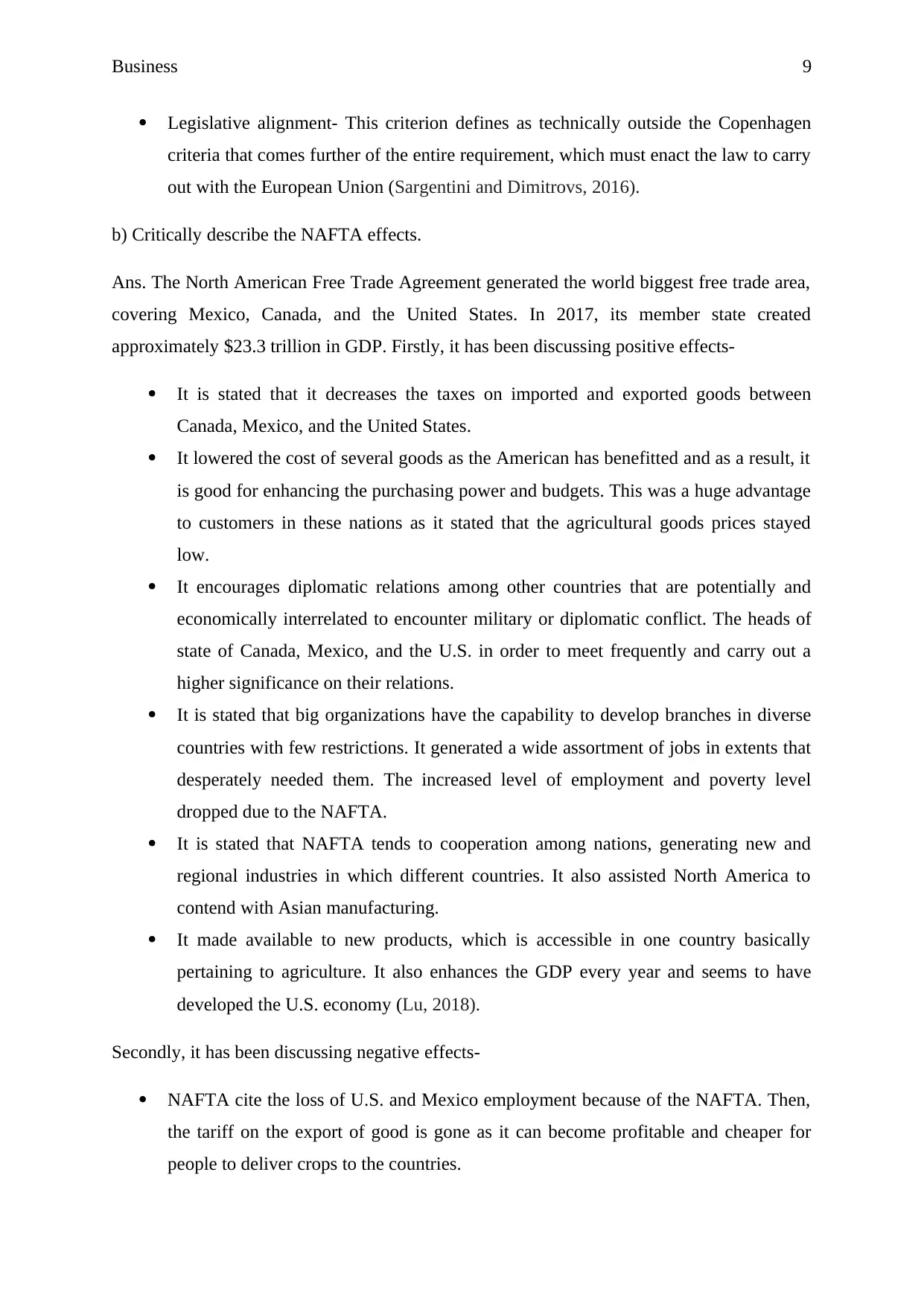
Business 9
Legislative alignment- This criterion defines as technically outside the Copenhagen
criteria that comes further of the entire requirement, which must enact the law to carry
out with the European Union (Sargentini and Dimitrovs, 2016).
b) Critically describe the NAFTA effects.
Ans. The North American Free Trade Agreement generated the world biggest free trade area,
covering Mexico, Canada, and the United States. In 2017, its member state created
approximately $23.3 trillion in GDP. Firstly, it has been discussing positive effects-
It is stated that it decreases the taxes on imported and exported goods between
Canada, Mexico, and the United States.
It lowered the cost of several goods as the American has benefitted and as a result, it
is good for enhancing the purchasing power and budgets. This was a huge advantage
to customers in these nations as it stated that the agricultural goods prices stayed
low.
It encourages diplomatic relations among other countries that are potentially and
economically interrelated to encounter military or diplomatic conflict. The heads of
state of Canada, Mexico, and the U.S. in order to meet frequently and carry out a
higher significance on their relations.
It is stated that big organizations have the capability to develop branches in diverse
countries with few restrictions. It generated a wide assortment of jobs in extents that
desperately needed them. The increased level of employment and poverty level
dropped due to the NAFTA.
It is stated that NAFTA tends to cooperation among nations, generating new and
regional industries in which different countries. It also assisted North America to
contend with Asian manufacturing.
It made available to new products, which is accessible in one country basically
pertaining to agriculture. It also enhances the GDP every year and seems to have
developed the U.S. economy (Lu, 2018).
Secondly, it has been discussing negative effects-
NAFTA cite the loss of U.S. and Mexico employment because of the NAFTA. Then,
the tariff on the export of good is gone as it can become profitable and cheaper for
people to deliver crops to the countries.
Legislative alignment- This criterion defines as technically outside the Copenhagen
criteria that comes further of the entire requirement, which must enact the law to carry
out with the European Union (Sargentini and Dimitrovs, 2016).
b) Critically describe the NAFTA effects.
Ans. The North American Free Trade Agreement generated the world biggest free trade area,
covering Mexico, Canada, and the United States. In 2017, its member state created
approximately $23.3 trillion in GDP. Firstly, it has been discussing positive effects-
It is stated that it decreases the taxes on imported and exported goods between
Canada, Mexico, and the United States.
It lowered the cost of several goods as the American has benefitted and as a result, it
is good for enhancing the purchasing power and budgets. This was a huge advantage
to customers in these nations as it stated that the agricultural goods prices stayed
low.
It encourages diplomatic relations among other countries that are potentially and
economically interrelated to encounter military or diplomatic conflict. The heads of
state of Canada, Mexico, and the U.S. in order to meet frequently and carry out a
higher significance on their relations.
It is stated that big organizations have the capability to develop branches in diverse
countries with few restrictions. It generated a wide assortment of jobs in extents that
desperately needed them. The increased level of employment and poverty level
dropped due to the NAFTA.
It is stated that NAFTA tends to cooperation among nations, generating new and
regional industries in which different countries. It also assisted North America to
contend with Asian manufacturing.
It made available to new products, which is accessible in one country basically
pertaining to agriculture. It also enhances the GDP every year and seems to have
developed the U.S. economy (Lu, 2018).
Secondly, it has been discussing negative effects-
NAFTA cite the loss of U.S. and Mexico employment because of the NAFTA. Then,
the tariff on the export of good is gone as it can become profitable and cheaper for
people to deliver crops to the countries.
Paraphrase This Document
Need a fresh take? Get an instant paraphrase of this document with our AI Paraphraser
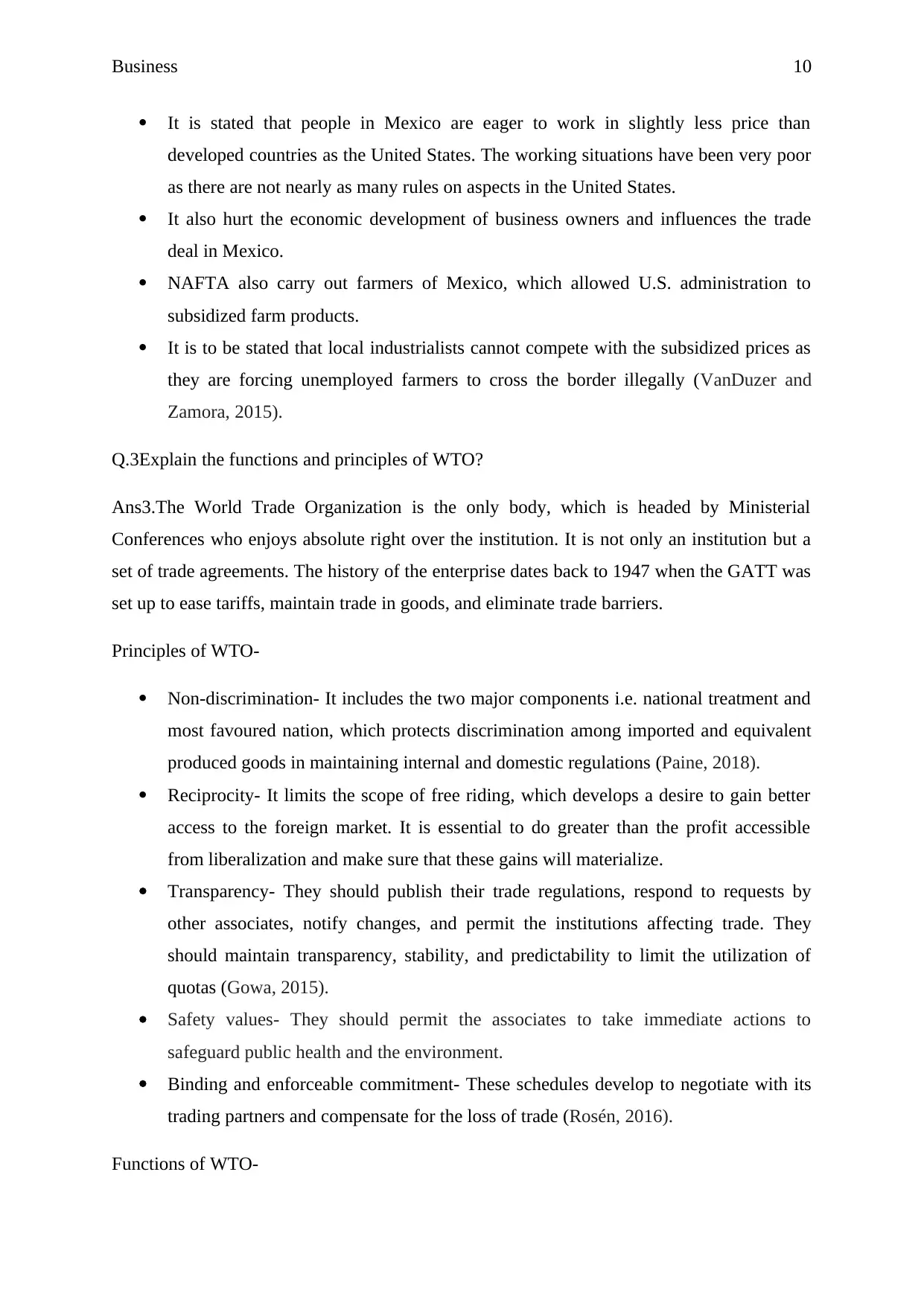
Business 10
It is stated that people in Mexico are eager to work in slightly less price than
developed countries as the United States. The working situations have been very poor
as there are not nearly as many rules on aspects in the United States.
It also hurt the economic development of business owners and influences the trade
deal in Mexico.
NAFTA also carry out farmers of Mexico, which allowed U.S. administration to
subsidized farm products.
It is to be stated that local industrialists cannot compete with the subsidized prices as
they are forcing unemployed farmers to cross the border illegally (VanDuzer and
Zamora, 2015).
Q.3Explain the functions and principles of WTO?
Ans3.The World Trade Organization is the only body, which is headed by Ministerial
Conferences who enjoys absolute right over the institution. It is not only an institution but a
set of trade agreements. The history of the enterprise dates back to 1947 when the GATT was
set up to ease tariffs, maintain trade in goods, and eliminate trade barriers.
Principles of WTO-
Non-discrimination- It includes the two major components i.e. national treatment and
most favoured nation, which protects discrimination among imported and equivalent
produced goods in maintaining internal and domestic regulations (Paine, 2018).
Reciprocity- It limits the scope of free riding, which develops a desire to gain better
access to the foreign market. It is essential to do greater than the profit accessible
from liberalization and make sure that these gains will materialize.
Transparency- They should publish their trade regulations, respond to requests by
other associates, notify changes, and permit the institutions affecting trade. They
should maintain transparency, stability, and predictability to limit the utilization of
quotas (Gowa, 2015).
Safety values- They should permit the associates to take immediate actions to
safeguard public health and the environment.
Binding and enforceable commitment- These schedules develop to negotiate with its
trading partners and compensate for the loss of trade (Rosén, 2016).
Functions of WTO-
It is stated that people in Mexico are eager to work in slightly less price than
developed countries as the United States. The working situations have been very poor
as there are not nearly as many rules on aspects in the United States.
It also hurt the economic development of business owners and influences the trade
deal in Mexico.
NAFTA also carry out farmers of Mexico, which allowed U.S. administration to
subsidized farm products.
It is to be stated that local industrialists cannot compete with the subsidized prices as
they are forcing unemployed farmers to cross the border illegally (VanDuzer and
Zamora, 2015).
Q.3Explain the functions and principles of WTO?
Ans3.The World Trade Organization is the only body, which is headed by Ministerial
Conferences who enjoys absolute right over the institution. It is not only an institution but a
set of trade agreements. The history of the enterprise dates back to 1947 when the GATT was
set up to ease tariffs, maintain trade in goods, and eliminate trade barriers.
Principles of WTO-
Non-discrimination- It includes the two major components i.e. national treatment and
most favoured nation, which protects discrimination among imported and equivalent
produced goods in maintaining internal and domestic regulations (Paine, 2018).
Reciprocity- It limits the scope of free riding, which develops a desire to gain better
access to the foreign market. It is essential to do greater than the profit accessible
from liberalization and make sure that these gains will materialize.
Transparency- They should publish their trade regulations, respond to requests by
other associates, notify changes, and permit the institutions affecting trade. They
should maintain transparency, stability, and predictability to limit the utilization of
quotas (Gowa, 2015).
Safety values- They should permit the associates to take immediate actions to
safeguard public health and the environment.
Binding and enforceable commitment- These schedules develop to negotiate with its
trading partners and compensate for the loss of trade (Rosén, 2016).
Functions of WTO-
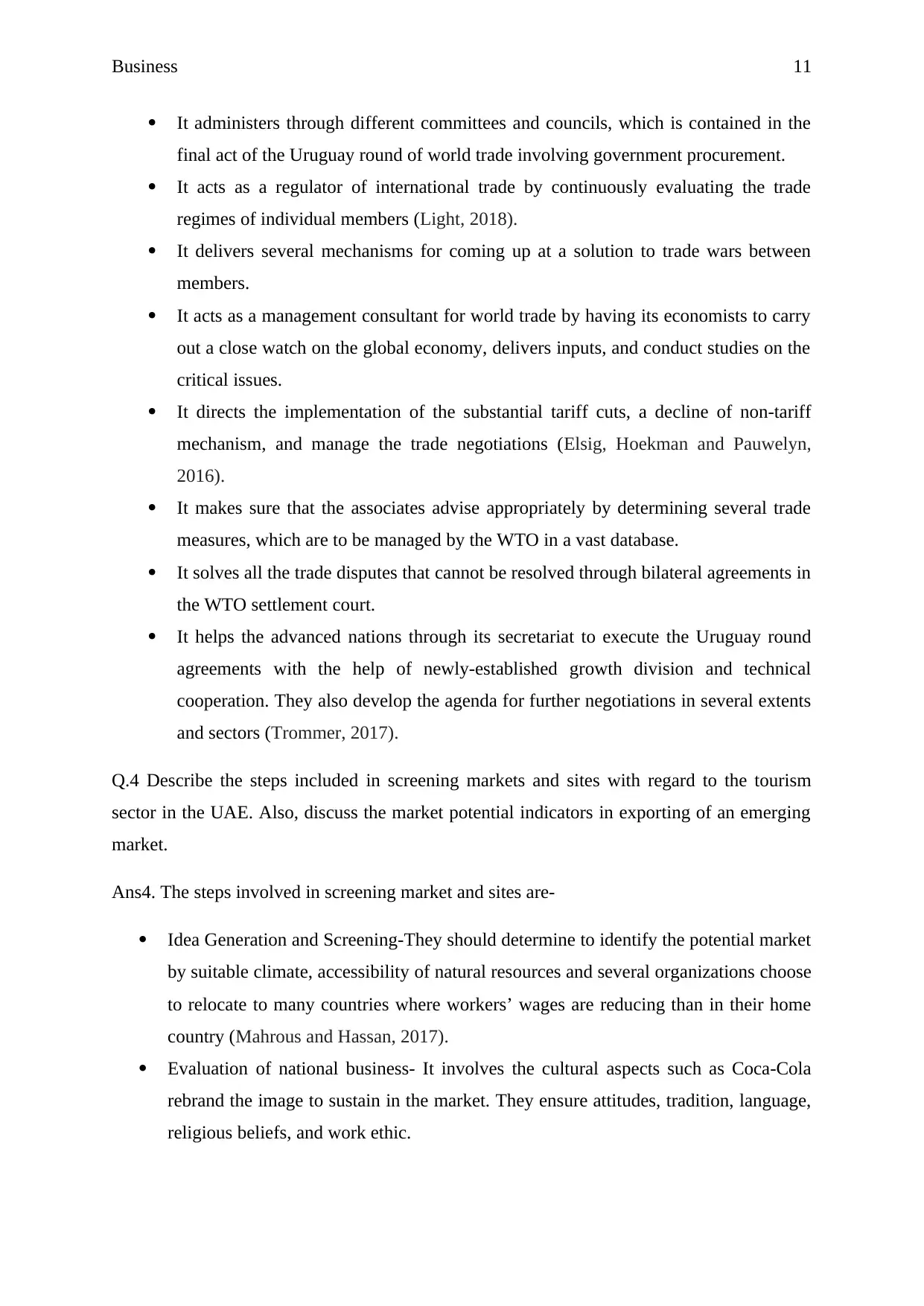
Business 11
It administers through different committees and councils, which is contained in the
final act of the Uruguay round of world trade involving government procurement.
It acts as a regulator of international trade by continuously evaluating the trade
regimes of individual members (Light, 2018).
It delivers several mechanisms for coming up at a solution to trade wars between
members.
It acts as a management consultant for world trade by having its economists to carry
out a close watch on the global economy, delivers inputs, and conduct studies on the
critical issues.
It directs the implementation of the substantial tariff cuts, a decline of non-tariff
mechanism, and manage the trade negotiations (Elsig, Hoekman and Pauwelyn,
2016).
It makes sure that the associates advise appropriately by determining several trade
measures, which are to be managed by the WTO in a vast database.
It solves all the trade disputes that cannot be resolved through bilateral agreements in
the WTO settlement court.
It helps the advanced nations through its secretariat to execute the Uruguay round
agreements with the help of newly-established growth division and technical
cooperation. They also develop the agenda for further negotiations in several extents
and sectors (Trommer, 2017).
Q.4 Describe the steps included in screening markets and sites with regard to the tourism
sector in the UAE. Also, discuss the market potential indicators in exporting of an emerging
market.
Ans4. The steps involved in screening market and sites are-
Idea Generation and Screening-They should determine to identify the potential market
by suitable climate, accessibility of natural resources and several organizations choose
to relocate to many countries where workers’ wages are reducing than in their home
country (Mahrous and Hassan, 2017).
Evaluation of national business- It involves the cultural aspects such as Coca-Cola
rebrand the image to sustain in the market. They ensure attitudes, tradition, language,
religious beliefs, and work ethic.
It administers through different committees and councils, which is contained in the
final act of the Uruguay round of world trade involving government procurement.
It acts as a regulator of international trade by continuously evaluating the trade
regimes of individual members (Light, 2018).
It delivers several mechanisms for coming up at a solution to trade wars between
members.
It acts as a management consultant for world trade by having its economists to carry
out a close watch on the global economy, delivers inputs, and conduct studies on the
critical issues.
It directs the implementation of the substantial tariff cuts, a decline of non-tariff
mechanism, and manage the trade negotiations (Elsig, Hoekman and Pauwelyn,
2016).
It makes sure that the associates advise appropriately by determining several trade
measures, which are to be managed by the WTO in a vast database.
It solves all the trade disputes that cannot be resolved through bilateral agreements in
the WTO settlement court.
It helps the advanced nations through its secretariat to execute the Uruguay round
agreements with the help of newly-established growth division and technical
cooperation. They also develop the agenda for further negotiations in several extents
and sectors (Trommer, 2017).
Q.4 Describe the steps included in screening markets and sites with regard to the tourism
sector in the UAE. Also, discuss the market potential indicators in exporting of an emerging
market.
Ans4. The steps involved in screening market and sites are-
Idea Generation and Screening-They should determine to identify the potential market
by suitable climate, accessibility of natural resources and several organizations choose
to relocate to many countries where workers’ wages are reducing than in their home
country (Mahrous and Hassan, 2017).
Evaluation of national business- It involves the cultural aspects such as Coca-Cola
rebrand the image to sustain in the market. They ensure attitudes, tradition, language,
religious beliefs, and work ethic.
⊘ This is a preview!⊘
Do you want full access?
Subscribe today to unlock all pages.

Trusted by 1+ million students worldwide
1 out of 17
Your All-in-One AI-Powered Toolkit for Academic Success.
+13062052269
info@desklib.com
Available 24*7 on WhatsApp / Email
![[object Object]](/_next/static/media/star-bottom.7253800d.svg)
Unlock your academic potential
Copyright © 2020–2025 A2Z Services. All Rights Reserved. Developed and managed by ZUCOL.


